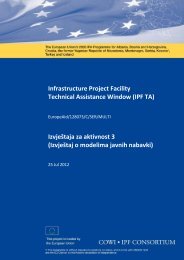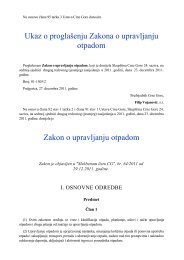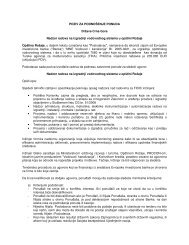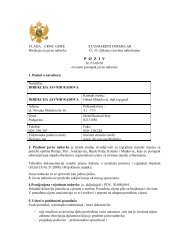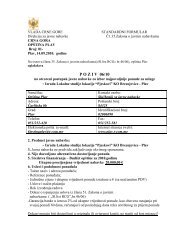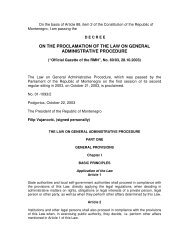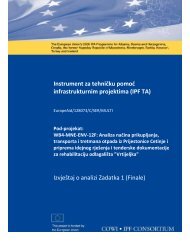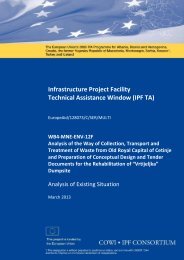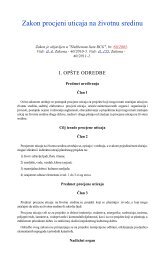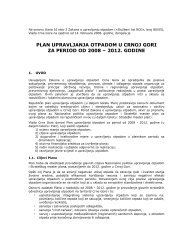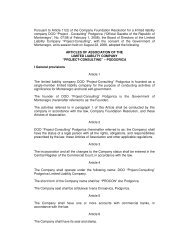Infrastructure Projects Facility Technical Assistance Window (IPF TA ...
Infrastructure Projects Facility Technical Assistance Window (IPF TA ...
Infrastructure Projects Facility Technical Assistance Window (IPF TA ...
Create successful ePaper yourself
Turn your PDF publications into a flip-book with our unique Google optimized e-Paper software.
<strong>Infrastructure</strong> <strong>Projects</strong> <strong>Facility</strong> – <strong>Technical</strong> <strong>Assistance</strong> <strong>Window</strong><br />
Sub project: WB4-MNE-ENV-12B: Management Models and Options for Cost Recovery for the Future Construction and<br />
Operation of Regional Landfills in Montenegro<br />
47<br />
• In accordance with "The demographic trends in Montenegro since the<br />
mid-20th century and prospects to 2050" (MONS<strong>TA</strong>T 2008), the population<br />
in Montenegro in 2050 would be higher than for the starting year<br />
2005. The results of the projection confirm that the process of depopulation,<br />
which in the northern region will probably continue at least until<br />
2015. For this reason, waste generation of 22,000 t/year over the period<br />
2013-2017 may be expected.<br />
• Percentage of recycled and uncollected waste will be 30% over the period<br />
2013-2017 (recycled 13%, uncollected 17%).<br />
• Increase in waste generation for the region over the period 2018-2022<br />
will be about 6% due to the estimated demographic growth of +0.81%<br />
(increase in waste producers) and GDP of +2.5%.<br />
• Percentage of recycled and uncollected waste will be 33% over the period<br />
2018-2022 (recycled 23%, uncollected 10%).<br />
• Increase in waste generation for the region over the period 2018-2022<br />
will be about 8%.<br />
• Percentage of recycled and uncollected waste will be 55% over the period<br />
2023-2030 (recycled 38%, uncollected 17%).<br />
Table 10 Waste generation forecast, 2013-2030<br />
Period Generated Recycled Uncollected Disposed<br />
2013-2017 113,525 14,758 19,300 79,467<br />
2018-2022 120,336 27,677 12,034 80,625<br />
2023-2030 207,936 79,015 14,557 114,364<br />
2013-2030 441,797 121,450 45,891 274,456<br />
Source: Consultant's assessment based on changing population growth data<br />
Landfill volume<br />
According to the foregoing table, solid waste in the amount of 274,456 tons<br />
will be disposed at the landfill over the period 2013-2030. Since the assumed<br />
density of compacted waste is 950 kg/m³, a landfill volume of 288,179 m³ net is<br />
needed for the waste.<br />
Assuming that 16% of inert material is necessary for covering, the value of total<br />
volume is 334.287 m³.<br />
Taking into account the value of available landfill volume of 330.000 m³ and<br />
the expected amount of generated waste for the following period, it can be concluded<br />
that based on current parameters that the landfill can be designed for the<br />
period of 18 years.<br />
The Nikšić PUC, in its services for the collection and disposal of waste, submitted<br />
information about collection of more than 40,000 tons waste per year. This<br />
assumption is based on the volume of solid waste transport trucks and the number<br />
of trips to the current dump; it is not based on measurements from a waste<br />
scale. The PUC also confirms that this amount includes waste from illegal<br />
dumps, construction and demolition waste, green waste and communal waste<br />
without any selection and recycling. The PUC concurs with the Consultant‟s<br />
.



